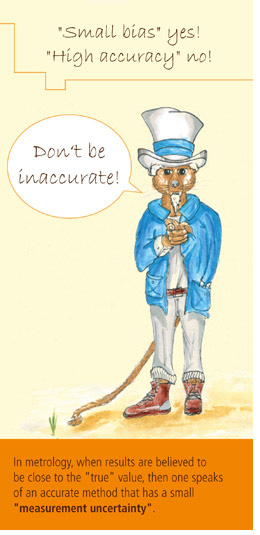Small Bias Yes, High Accuracy No
 Accuracy relates to observations on a single measurement, trueness is a similar concept applied to measurements made by a technique and, in both cases, the difference between these measurements and a measurement standard is quantified by bias.
Accuracy relates to observations on a single measurement, trueness is a similar concept applied to measurements made by a technique and, in both cases, the difference between these measurements and a measurement standard is quantified by bias.
Bad practice
Accurate and precise analyses …
Reproducibility and accuracy …
… such analytical precision may give rise to problems when accuracy is evaluated …
Good practice
Measurement results with low uncertainties …
Measurement precision and bias estimations …
… such measurement precision may give rise to problems when measurement bias is evaluated …
Commentary
The traditional understanding of the term accuracy changed with the publication of VIM 3 to become specifically the closeness of agreement between a measurement and the true quantity value of that measurand. Thus, accuracy can be assessed by a comparing the measurement of an element in a certified reference material with its certified value. The magnitude of this difference is quantified as the bias in the measurement. However, when the same approach is followed with a large number of measurements, the property being evaluated is the trueness of the technique.
The use of the adjectives ‘high’ and ‘low’ with these properties can cause confusion in the sense that high accuracy must be associated with low bias.
DEFINITIONS
Measurement accuracy (accuracy of measurement, accuracy)
Closeness of agreement between a measured quantity value and a true quantity value of a measurand.
NOTE 1 The concept ‘measurement accuracy’ is not a quantity and is not given a numerical quantity value. A measurement is said to be more accurate when it offers a smaller measurement error.
NOTE 2 The term “measurement accuracy” should not be used for measurement trueness and the term “measurement precision” should not be used for ‘measurement accuracy’, which, however, is related to both these concepts.
NOTE 3 ‘Measurement accuracy’ is sometimes understood as closeness of agreement between measured quantity values that are being attributed to the measurand. (VIM 3: 2.13)
Measurement trueness (trueness of measurement, trueness)
Closeness of agreement between the average of an infinite number of replicate measured quantity values and a reference quantity value.
NOTE 1 Measurement trueness is not a quantity and thus cannot be expressed numerically, but measures for closeness of agreement are given in ISO 5725.
NOTE 2 Measurement trueness is inversely related to systematic measurement error, but is not related to random measurement error.
NOTE 3 “Measurement accuracy” should not be used for ‘measurement trueness’. (VIM 3: 2.14)
Measurement bias (bias)
Estimate of a systematic measurement error. (VIM 3: 2.18)
Index to terms
| Concept | Metrological terms considered | Metrological terms covered |
| Say no to ppm | The ambiguities associated with the use of ‘ppm’ | |
| Sigma is out, standard deviation is the way to go! | What symbols are used to represent the properties of population- and sample-distributions | |
| Standard ≠ reference material | Avoiding the use of the term standards when referring to (certified) reference materials or calibrators | Reference material, certified reference material, standard reference material, calibrator, calibration, validation, measurement standard (étalon), verification |
| Please, no more errors from your laboratory | Explaining the difference between uncertainty and error | Measurement uncertainty, measurement error, systematic measurement error, measurement bias, random measurement error, confidence level |
| Precision | Distinguishing between repeatability, intermediate precision and reproducibility and discouraging the use of ‘internal precision’ | Measurement precision, repeatability condition of measurement, intermediate precision of measurement, reproducibility condition of measurement, repeatability, intermediate precision, reproducibility |
| Small bias yes, high accuracy no | Explaining the difference between accuracy, bias and trueness | Measurement accuracy, measurement trueness, measurement bias |

